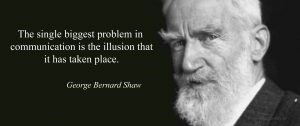George Bernard Shaw wisely remarked, “The single biggest problem in communication is the illusion that it has taken place.” So, what defines an impactful keynote speaker? Is it their ability to merely deliver a presentation, or is it their capacity to inspire action?

In the realm of sales, success isn’t achieved by merely pitching a product but by securing a purchase from the customer. Similarly, keynote speakers need to “close the deal” to be truly effective.
But what does “closing” mean for a speaker? It demands a shift from a KEYnote mindset (“I am the most important speaker here today. You will listen to and learn from me.”) to a “WEnote” mindset (“My role is to anchor this audience in a common purpose. I will listen to and adapt to them.”). This shift leaves the audience with a genuine desire to act on something meaningful to them rather than passively listening to a story.

A New Kind of Keynote…
Here are the three fundamental principles of a WEnote:
1. It’s Not Me, It’s You
As Ben and Kelly Decker pointed out in their HBR article, effective communication style should be situational. Keynote speakers must aim for emotional connection and audience-centered content. This can be achieved through advanced interviews with select participants or by asking the audience questions during the presentation and using their responses as starting points throughout the presentation. Engaging the audience by showing them what’s in it for them, instead of delivering a canned presentation and expecting them to connect the dots, ensures higher engagement.

2. Action Speaks Louder Than Words
Communication is only 7% verbal. Body language and tone of voice dominate the message being delivered. Hiding behind a podium or on a raised stage can limit your connection with the audience. Walking around the room with a handheld or lapel mic can transform a keynote into a WEnote, allowing you to engage with more people, gauge the connection, and infuse energy into the room. Traditionally, only 5% of a lecture is retained; however, breaking from tradition by encouraging the audience to discuss the topic with you and among themselves before or during your keynote, and inspiring them to take action immediately afterward, significantly improves their retention of your presentation.

3. Three What’s and No How
- A great WEnote should answer three key questions for the audience: What, So What, and Now What. What are you sharing with me? Why are you sharing it with me? And what will I do with it? Many keynote presentations stop at the first “What” – a story is told, slides are shown, but little connection is made, and few are motivated to take action. The crucial aspect is to connect without constraining the audience. As Simon Sinek aptly points out, it’s the “I have a dream speech,” not the “I have a plan speech.” Inspiration arises from painting a clear picture of “what could be.” “How do we get there” is best left for the audience to ponder. This question is what will propel them to take action after the WEnote experience, enabling them to bring their individual strengths and perspectives to the challenge at hand.
Book Julien for your Next Event!
If you’re ready to transform your event into an unforgettable experience of inspiration and action, book Julien for a WeNote today!



